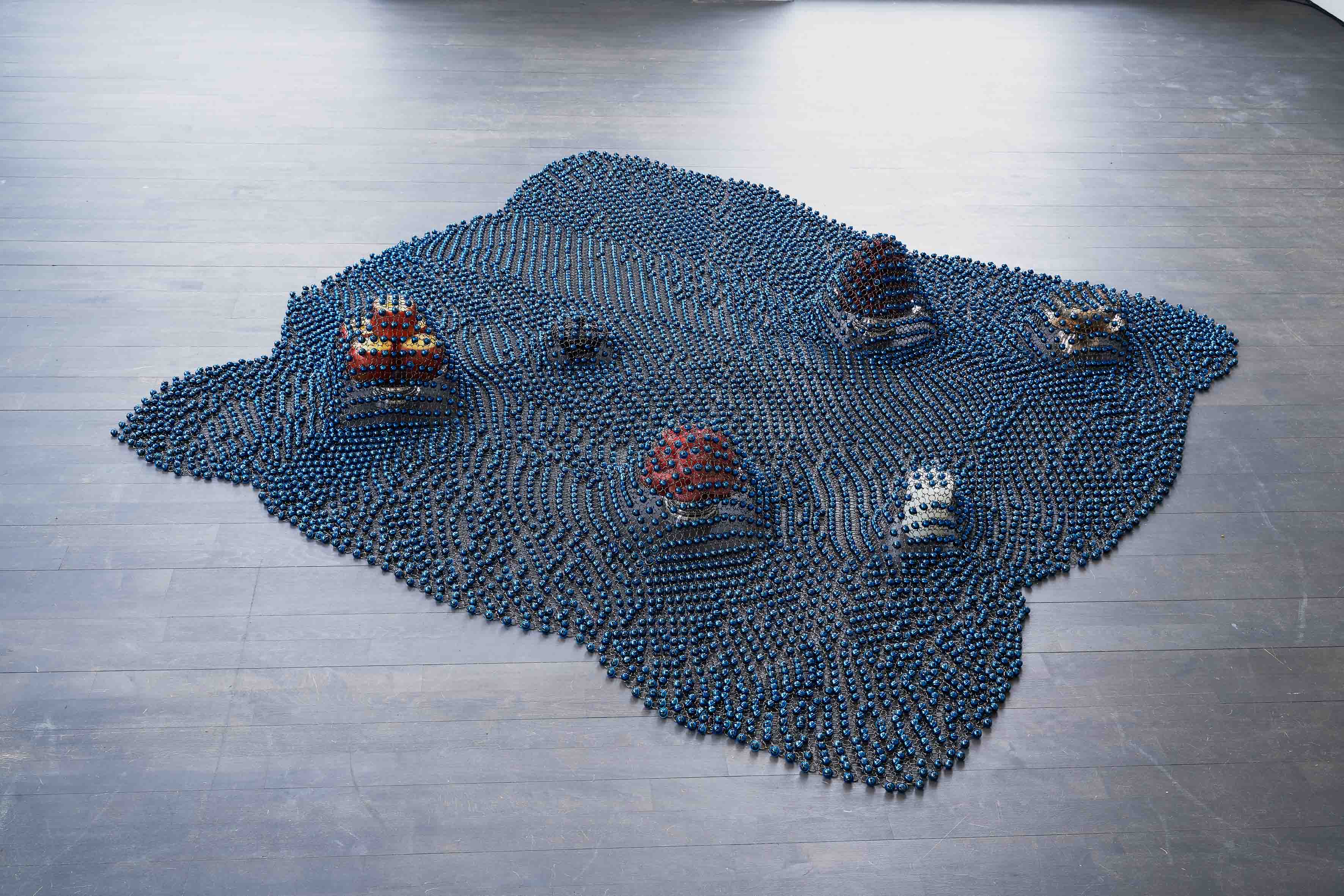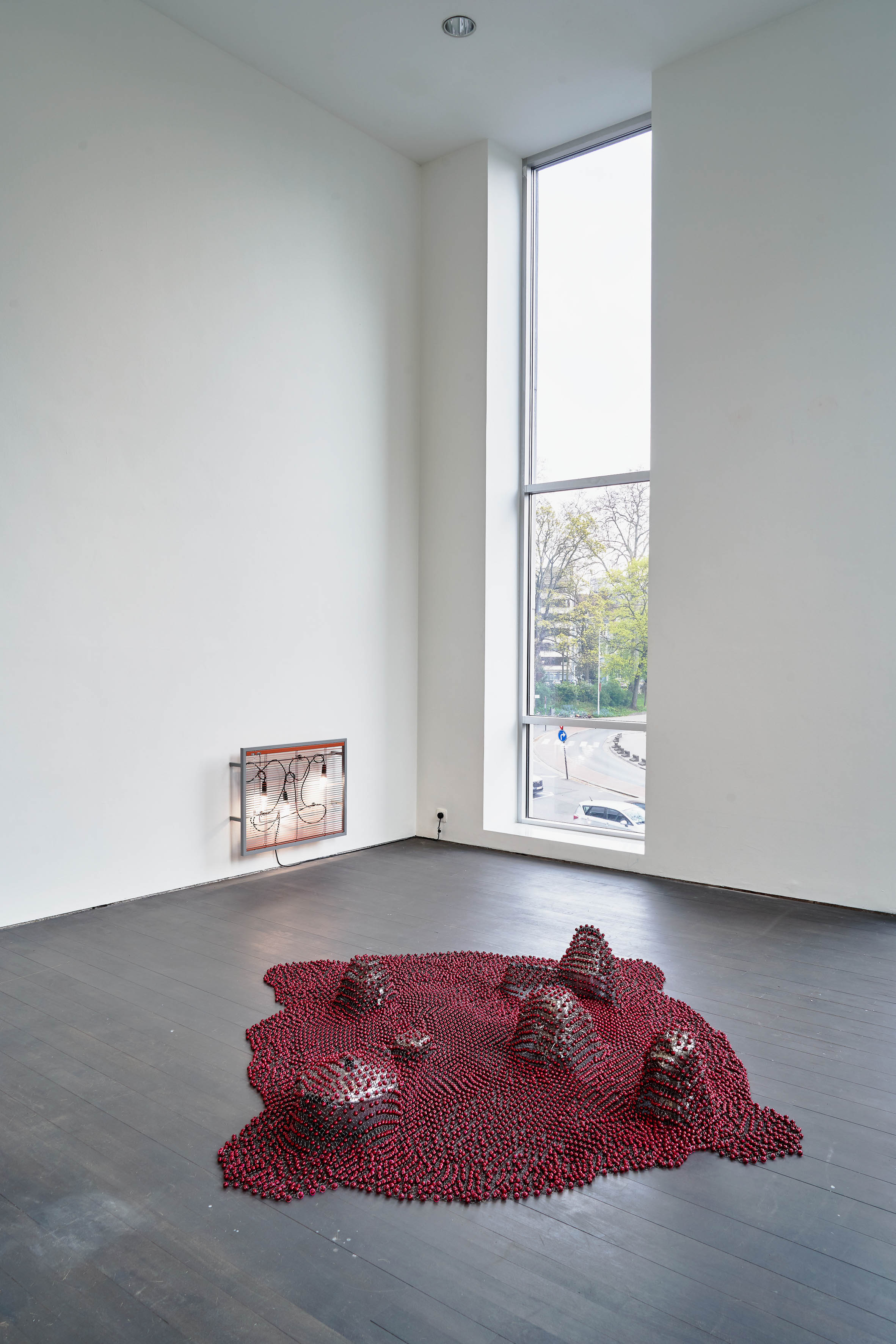YYYYMMDD >>> BACK HOME <<< >>> SELECTED FEATURES <<< >>> HIDDEN ARCHIVE <<<
[20230424]
SEVERAL REENACTMENTS by HAEGUE YANG at S.M.A.K. [from 20230422 to 20230910]
[Photos: Dirk Pauwels]
















S.M.A.K. is honoured to be the first museum in Belgium to present a solo exhibition by the internationally renowned artist Haegue Yang (b. 1971, Seoul). Entitled Several Reenactments, the exhibition pivots on notions of recurrence as well as Yang’s preoccupation with doubling, mirroring, and dividing. In her work, Yang seeks out the obscure, mysterious and yet inherently logical qualities of repetition. A process of continuous and intensive circling creates a strong intercontextuality in her practice, to the extent that her works often appear as pairs or interconnected groups. In the Cabinet Galleries on either side of the main hall, which mirror each other, Yang creates displays that are nearly symmetrical. In the central gallery, she presents a reenactment of an earlier sculptural ensemble.
The Source of Spring is in the Trace of Movement (2021) is the first artwork one encounters in the exhibition. This print edition on paper is an adaptation of the inscription on the historical marquetry floor of the South London Gallery, designed by artist and socialist activist Walter Crane (1845-1915). Yang has borrowed the original inscription “The Source of Art is in the Life of a People”, which refers to the idea that art, literature and learning should be available to all and not just the privileged few. The gallery made art accessible to the overlooked working-class people living in South London. In her print edition, Crane’s profound artistic commitment to the people is reenacted in support of the recent mass pro-democracy protests in Myanmar. The original Victorian vegetal and floral ornamentation is partially replaced by healing plants native to the Southeast Asian country. Nestling amongst them is a three-finger salute that alludes not only to the people of Myanmar’s hunger for democracy but also to our own socio-political empathy for their plight.
Dispersed in and populating the main hall is Warrior Believer Lover – Version Sonic (2023), undoubtedly the central work in the exhibition. This is a new, yet incomplete reenactment of Warrior Believer Lover, an installation of thirty-three Light Sculptures that premiered at the Kunsthaus Bregenz in 2011. The panoramic sculptural field at S.M.A.K. is a daring attempt to portray non-conformist archetypes: the warrior, fighting intensely for something, the believer, who lives life with absolute faith, and the lover, who courageously exposes oneself to another. Echoing Yang’s desire to honour these uncompromising qualities, all of which are underpinned by a profound sense of dedication, the new sculptures are tributes to figures who strictly adhere to their own values. The Ghent reenactment comprises seventeen Sonic Sculptures that are primarily made of bells, elements that are one of Yang’s current signature materials. Like the preceding Light Sculptures, Warrior Believer Lover – Version Sonic is an ensemble divided into distinct individual sculptures and groups of two, three, or six. Each cluster has a distinctive title, including Sonic Female Natives, Sonic Medicine Men, Sonic Totem Robots, Sonic Pine Spells, and Sonic Stone Dance. Warrior Believer Lover – Version Sonic is made from a vast array of artisanal and industrially manufactured objects, arranged rigorously, lending the work a remarkable complexity. Adorned with artificial plants, wigs, and solar lamps, the sculptures resemble small anthropomorphic figures, each of which boasts a unique personality and history. They explore the limits of nature and artifice, as well as totemic and ritualistic movement. Warrior Believer Lover – Version Sonic is accompanied by Igor Stravinsky’s legendary ballet music, Le Sacre du Printemps (1913), which references the pagan spring sacrifices of the First Nations. Stravinsky’s atonal orchestration for the Ballets Russes and the history of the avant-garde is juxtaposed with Islamic prayer times.
With its horizontally open sculptural field Warrior Believer Lover – Version Sonic breaks down the monumentality of the main hall in a radical way. The walls are painted in a colour that Yang refers to as ‘Quasi-Yves Klein Blue’. Amongst the several shades offered by a local paint supplier, S.M.A.K.’s team voted on the tone of blue that most closely matched International Klein Blue, or IKB, the cobalt hue licensed by the French artist Yves Klein. For Yang, ‘quasi’ – meaning something almost like the original, yet not quite – is a recurrent question that touches upon notions of originality and alleged authorization. In applying ‘Quasi-Yves Klein Blue’ to the walls, Yang uses local products to repetitively reenact the desired ‘falseness.’
Displayed against this blue background are seven artworks from the series Trustworthies (2010 - 2020), and one from Mesmerizing Mesh (2021, on-going). These showcase Yang’s engagement with paper collage techniques as well as her exploration of symmetry and geometric patterns. While Trustworthies utilises the security patterns printed on the insides of envelopes, Mesmerizing Mesh draws on the use of mulberry paper in various shamanistic rituals in Korea and other ritualistic or folk paper-cutting traditions from around the world. The Chinese character that means ‘joy’, 喜, has been duplicated to create the two-part paper collage piece Flourishing Great Rejoicing Soul Glyph – Mesmerizing Mesh #169 (2023). Reflecting the doomed Europe with the war and the precarious economy, Yang chose 喜 as an encouraging message. In the exhibition, two Mesmerizing Mesh pieces are placed on either side of the main hall, above the entrance to each Cabinet Gallery, again mirroring each other. Since visitors can walk under them to enter the side rooms, their location hints at a potential talismanic role.
In the left and right Cabinet Galleries, Yang presents two versions – or perhaps doubles – of Jahnstraße 5 (2017), again as a mirrored installation. These are an extension of her Appliance Sculptures, a category of work in which Yang abstracts domestic devices. Jahnstraße 5 features groupings of box-like metal structures, filled with tangled cables and light bulbs, which are veiled by the colour gradations in the Venetian blinds on their front side. Jahnstraße 5 replicates the dimensions, shapes and location of the heat-generating devices in the artist’s former home in Berlin, such as a water boiler and radiators. Through the lights, Yang infuses Jahnstraße 5 with a warmth that evokes the essentiality of domestic heat. In so doing, she reconciles personal and abstract experiences of the everyday while reflecting on ideas of home, care, and belonging.
In dialogue with Jahnstraße 5, a carpet, woven from metal bells and rings, is positioned in each Cabinet Gallery. Sonic Guard over Ceremonial Formation – Blue (2022) and Sonic Guard over Domestic Formation – Crimson (2022) are spread comfortably on the floor, lying over some objects. While the blue one covers several objects from a table setting used in Korean ancestral rites, the crimson one guards ordinary metal food containers.
Continuing these mirroring gestures, two video pieces are placed in both Cabinet Galleries: Video Trilogy (2004 - 2006) consisting of three films and Doubles and Halves – Events with Nameless Neighbors (2009), the latter of which was filmed in Seoul and Venice. Doubles and Halves features a voice-over singing proudly about the poor and run-down neighbourhood of Ahyeon-dong, the artist’s residence in Seoul at that time, as well as the hidden spaces around the Korean Pavilion at the Giardini Park in Venice, the site of the international art biennale. Yet each place resembles the other since both were shot with insufficient light, either at sunset or sunrise. In 2004, Yang edited footage in Amsterdam, Berlin, Frankfurt, Incheon, London and Seoul. The resulting video essays Unfolding Places and Restrained Courage depict a sensorial investigation of these cities. In 2006, the artist completed Video Trilogy by drawing on the cityscape of São Paulo to compose an unsettling allegory of displacement and wandering in Squandering Negative Spaces. Yang’s footage gathered on a handheld camera is reminiscent of a traveller composing moving collages, where opposites operate as guides.
The exhibition is realised in partnership between S.M.A.K. and HAM Helsinki Art Museum, Helsinki, Finland. With the support of the Ministry of Culture, Sports and Tourism of Korea / Korean Cultural Center Brussels; Galerie Barbara Wien, Berlin; Galerie Chantal Crousel, Paris; and dépendance, Brussels.
Haegue Yang was the winner of the Wolfgang Hahn Prize from Gesellschaft für Moderne Kunst, Ludwig Museum, Cologne in 2018 and the 13th Benesse Prize at the Singapore Biennale in 2022. Her work has been featured in solo exhibitions at the following institutions: Pinacoteca de São Paulo (2023); SMK – National Gallery of Denmark, Copenhagen (2022); Tate St Ives (2020); MoMA, New York (2019); The Bass, Miami Beach (2019); Museum Ludwig, Cologne (2018); Centre Pompidou, Paris (2016); Leeum Museum of Art, Seoul (2015); Kunsthaus Bregenz (2011); South Korea Pavilion, 53rd Venice Biennale (2009); amongst others.
[Text: S.M.A.K.]
©YYYYMMDD All content and design by Daniela Grabosch + Ricardo Almeida Roque unless otherwise stated. Images, Videos and Texts can only be used under permission of the author(s).